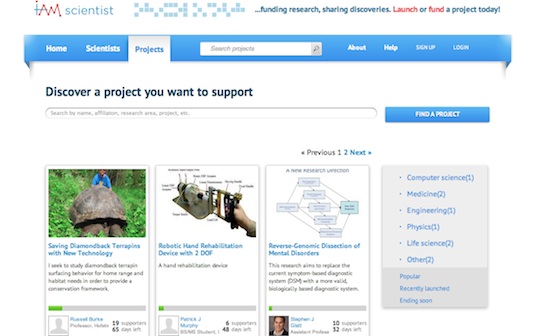iAMScientist Looks to Crowdfunding to Support Scientific Research. Here’s Why You Should Care
Ask any scientist in the university system what they spend most of their time doing, and the answer may surprise and disappoint you. Generally speaking, it’s not science. I’s not even grading papers or overseeing students to nurture a new generation of researchers and innovators. Filling out grant paperwork is the single activity that dominates the days of all too many researchers and academics. Massachusetts based startup iAMScientist wants to change that by acting as a Kickstarter for scientific pursuits and research projects.
iAMScientist will be familiar to anyone who’s seen Kickstarter in action: It allows scientists to propose experiments and research and take them directly to people. If the project is something you might be interested in — like saving diamondback terrapins, for instance — you can kick a couple of dollars their way. If the project hits its funding goal, it goes ahead, and you get a neat little trinket for your support, ranging from a thank you letter to a tour of the lab. If it doesn’t get the support it needs from the community, it goes nowhere. But even projects that don’t get funded could drum up a little attention that they might not otherwise receive, and giving scientists a platform to take their ideas directly to people — and impetus to be better communicators about their work — is a great thing in our book.
It’s not the first site to offer these services — PetriDish.org beat them to market — but it is the first that’s trying to pull double duty, also hoping to act as a social media hub for researchers to find collaborators and get advice from peers.
So, maybe the bigger questions is why is iAmScientist a thing? Isn’t putting money behind research the sort of thing that colleges and organizations like the NIH do? Yes and no. Funding is a persistent problem in the academic community. With many universities tightening belts, grant funds that are already stretched thin are even more in demand. Many experiments require a lot of lead time and involvement to arrange, and result in a lot of data to parse and analyze later on, all of which comes with a hefty price tag. From purchasing equipment to paying grad students, costs can run high. That means researchers often find themselves in a position of having to sing for their supper.
This is more than an inconvenience. High-pressure competition for grants means that scientists spend more time than they would like, but the problem is more insidious than that. Since far-flung notions or out-there projects are less likely to get funding, scientists are less likely to propose them. Rather than propose bold experiments, researchers go with safe ones that have better chances of getting funded. That narrows the scope of ideas that even make it to the drawing board stage and gives the idea of really brave innovation and transformative science a sharp kick to the curb.
Compounding the problem, many universities take grant portfolios — how much grant money a professor has brought in, and from where — into account when making tenure decisions. That means researchers can feel pressured to pursue expensive projects that build incrementally on earlier work instead of new ideas, even if those ideas could be tested on the cheap.
Okay, end of rant, but if you’re interested in the myriad reasons that the science funding system in the U.S. is screwed right to the wall, you can read an excellent breakdown of the problems endemic to the process over at Scientific American. And it’s not just an American problem, as Cambridge zoologist Peter Lawrence pointed out in the journal PLoSBiology.
iAMScientist is far from a panacea for the science funding system. For all its problems, the grant system usually has actual doctors and researchers determining the worthiness of funding a project — not just people saying, “Hey, that looks cool!” on the Internet. If you’ve ever read a YouTube comment thread, that prospect should chill you to the very core, and with only nine experiments up for funding as of this post, the scope of the site seems a bit limited.
Warts and all, though, this looks for all the world like a step in the right direction, however small. After all, the first step in recovery is acknowledging that you have a problem.
(h/tVentureBeat)
- Crowdfunding science should not prevent you from doing it for video games as well
- Or awesome looking cookbooks
- Or Amanda Palmer, for that matter
Have a tip we should know? tips@themarysue.com
